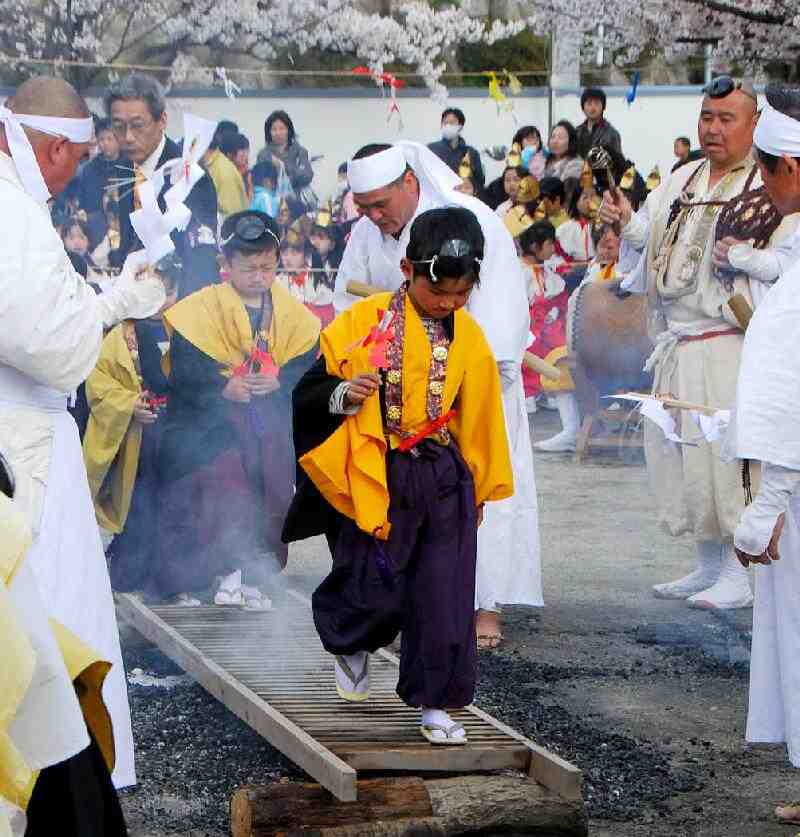
Individual Japanese Festivals: Cherry Blossom Festivals

Figure 1.--At this Shinto Syunka (spring) festival there is a ceremony where the participants walk over ashes of the cherry blossoms. First come the priests followed by the parents. The adults walk over the ashes barefoot. The children who wear traditional costumes walk over a liitle platform above the ashes. We are not sure where this festival was held. Notice the cherry blossoms in the background.
|
|
The cherry blossom is very important in Japanese society. It is Japan's most beloved flower and has the virtual status of the national flower. (The chrysanthemum represents the emperor.) There is no one single festival, but a huge number of local events. And given the north/south orintation of the Home Islands, the local festivals are set at slightly different dates from late-March to early-April cherry blossoms herald the the arrival of spring. Both the school acdemic year and corporate fiscal years begin with spring (April). Cherry treems bloom in Japan around the beginning of April (late March and early April). There is huge media attention and weather reporting thoughout Japan on just when the trees burst into bloom. The trees bloom for about 7-10 day and then they are gone. The delicate beauty and transience of the blossoms have poignant appeal and have been treated endlessly in Japanese poetry. The Japanese people come out in mass to enjoy the spring weather and gaze up at the beauty of the bloosoms. People bring food and drink to the prks and other places with cherry trees and spread out their picnics beneath the trees. Schools hold commencement ceremonies for the entering first-year students. The first-graders receive a brand-new school satchel (randoseru) from their parents or grandparents. Festivals occur throughout the country. We believe that the Shinto festivals are particularly important. We do not know much about the Shinto ceremoies involved here. The Japanese can mix Shinto and Buddhist ceremonies. I think that the individuals here are Buddhist monks (figure 1). There were also Shinto priests involved in the ceremony. We note some of these cherry bloosom festivals referred to as Syunka festival. Our understanding is that this means spring festival. The cheery bloosom festivals or ceremonies seem to be one type of Syunka festival (matsuri). Hopefully our Japanese readers will orovide some insights here.
Importance
The cherry blossom is very important in Japanese society. It is Japan's most beloved flower and has the virtual status of the national flower. (The chrysanthemum represents the emperor.) Cherry blossoms herald the the arrival of spring. Both the school acdemic year and corporate fiscal years begin with spring (April). The delicate beauty and transience of the blossoms have poignant appeal and have been treated endlessly in Japanese poetry.
Dates
Cherry treems bloom in Japan around the beginning of April (late March and early April). There is huge media attention and weather reporting thoughout Japan on just when the trees burst into bloom. The trees bloom for about 7-10 day and then they are gone.
Family Celebration
The Japanese people come out in mass to enjoy the spring weather and gaze up at the beauty of the blossoms. People bring food and drink to the prks and other places with cherry trees and spread out their picnics beneath the trees.
There is no one single festival, but a huge number of endlessly varied local events. And given the north/south orintation of the Home Islands, the local festivals are set at slightly different dates from late-March to early-April depending on when the trees usully blossom. Festivals occur throughout the country. We believe that the Shinto festivals are particularly important. We do not know much about the Shinto ceremoies involved here. The Japanese can mix Shinto and Buddhist ceremonies. I think that the individuals here are Buddhist monks (figure 1). There were also Shinto priests involved in the ceremony. We note some of these cherry bloosom festivals referred to as Syunka festival. Our understanding is that this means spring festival. The cheery blossom festivals or ceremonies seem to be one type of Syunka festival (matsuri). Hopefully our Japanese readers will orovide some insights here.
School Events
Schools hold commencement ceremonies for the entering first-year students. The children begin the school year at about the same time as the trees bloom. Thus there is an association. The first-graders receive a brand-new school satchel (randoseru) from their parents or grandparents.
HBC

Navigate the Boys' Historical Clothing Web Site:
[Introduction]
[Activities]
[Biographies]
[Chronology]
[Clothing styles]
[Countries]
[Bibliographies]
[Contributions]
[FAQs]
[Glossary]
[Images]
[Links]
[Registration]
[Tools]
[Boys' Clothing Home]
Navigate the Boys' Historical Clothing Japanese pages:
[Return to the Main Japanese individual festival page]
[Return to the Main Japanese festival page]
[Return to the Main Japanese page]
[Choirs]
[Department store catalogs]
[Monarchy]
[Music recitals]
[Youth groups]
[School uniforms]
Created: 1:10 PM 10/15/2008
Last updated: 3:31 PM 7/27/2017



